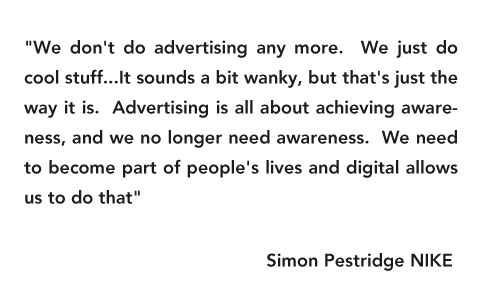Following the articles by Jill and Ivan, I thought I too, should delve into why people buy the things they do.
My boyfriend recently asked me a really interesting question: “Do you think people buy TOMS Shoes for the design or because of their One-for-One initiative?”.
I would think the answer would be “Both” – Take Jill’s personal recollection of her decision-making process when it came to TOMS. She was initially attracted to the style and comfort of the product, but it was the cause that tipped the scales and ultimately drove her to purchase the shoes. The original question made me think hard though – Are there actually people who would purchase TOMS Shoes solely or largely based on simply the cause?
This brings me to the theme of this post:
“People buy WHY you do it, they don’t buy WHAT you do.”
I, for one, am not a big fan of the design of TOMS Shoes, but their buy-one-give-one shoe initiative most definitely gives me a big push towards that act of purchase. In fact, I don’t even like the shoes! But I want to help. I believe in their cause and beliefs. On one hand, I don’t identify with the actual product, but on the other, everything about TOMS Shoes feels right.
At the end of the day for me, it comes down to a basic cost-benefit analysis. Can I afford $50 to re-enforce my belief that helping people the TOMS way is right? An interesting perspective to explore, is the possibility of putting a monetary value to a firm’s set of believes, or purpose. For instance, if I value a pair of TOMS Shoes at $30 (while in reality it retails at $50+), can the firm’s purpose justify the additional $20 I’d be paying for its product?
In this competitively intensive era, brands now more than ever need to clearly communicate their philosophy, mission and purpose, as these are they key decision criteria behind a consumer’s purchase intent.
Jill talks about Cause Marketing 2.0, where brands and non-profits are able to spread their message in new ways through the power of social media and user-generated content. It’s true – the internet opens the door to boundless opportunities for firms to “touch” consumer lives.
Nowadays it is what you’re saying that counts not how or what you’re selling. Bringing purposeful, interesting and entertaining ideas to consumers is the new focus in order to develop stronger relationships and foster brand loyalty.
One of my favourite examples is Coca-Cola’s shift in strategy in the way they deliver their brand promise of spreading happiness.
https://www.youtube.com/watch?feature=player_embedded&v=x_9fQEqZCWs
Another favourite:
To end off: Brands must consider what matters at the heart of their people in order to relate with them on a deeper level. And this isn’t just applicable to firms and actual brands – even in promoting yourself, always remember that people buy WHY you do it, not WHAT you do.”


